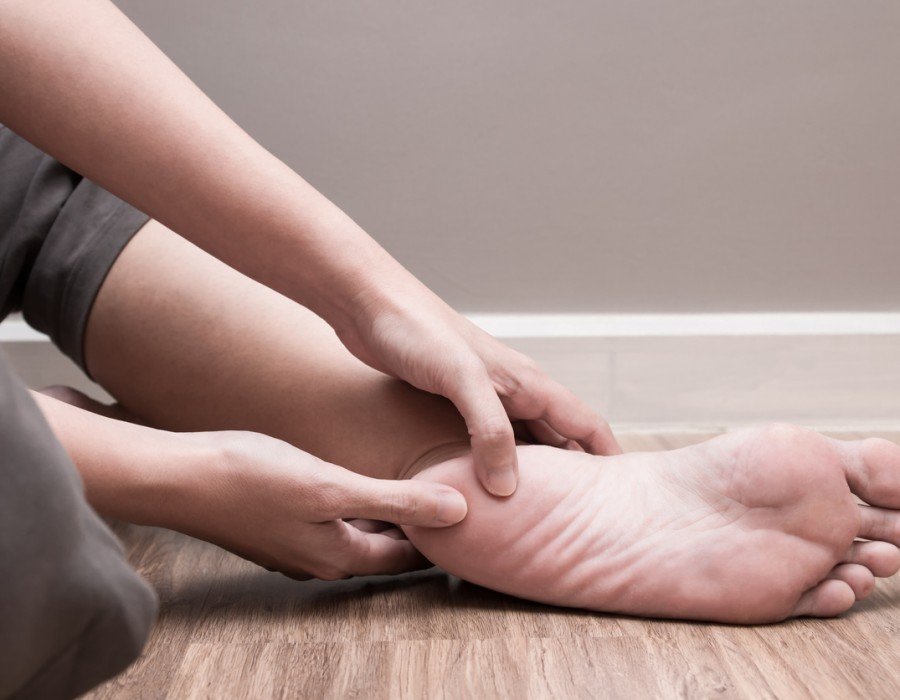Fitness and Performance
Forget Plantar Fasciitis in five steps

At Bodyset we pride ourselves on helping you feel better quickly. We also love to help you understand your injury or condition in detail. Today the spotlight is on plantar fasciitis. we’re going to explain what this condition is, why plantar fasciitis happens and how it should be treated.
What is plantar fascia?
Plantar fascia is the thick, strong tissue that forms the foot arch at the bottom of the foot. This fascia has several roles: it acts as a shock absorber; supports the foot arch; and helps to propel us forward when we walk or run. Plantar Fasciitis is the name of the condition when the tissue becomes irritated and inflamed, which can lead to heel pain and stiffness while walking.
What causes plantar fasciitis?
There are several causes of this painful condition. The most common sources are listed below.
- Heel bone spurs
- Poor gait biomechanics (how you walk and stand)
- Weakness of the foot muscles
- Repetitive stress in the plantar fascia (can especially affect runners, jumpers, people with very active jobs that involve being on their feet often)
- Myofascial (muscles and fascia) restrictions in the foot and legs
- Obesity or sudden weight gain
- Flat feet or high arches
- Discrepancy in leg length
- Incorrect or uncomfortable footwear
In many of these cases, the plantar fascia is subject to excessive and repetitive strain. This results in the inflammation of the tissue, causing pain and dysfunction.
In all cases of planta fasciitis, the symptoms presented are the same. However, it’s very important to identify the root cause of the issue. This allows us to treat and manage it appropriately and prevent its recurrence in the future.
Treatment of plantar fasciitis
The initial goal in plantar fasciitis rehab is the reduction of inflammation. This will significantly decrease your pain and will immediately allow you to walk easier. The focus of recovery then shifts to focus on reducing myofascial tightness and increasing strength in the foot and leg muscles. Finally, we look at improving gait biomechanics.
Your steps to recovery…
Stretching
In many cases, plantar fasciitis is caused by myofascial adhesions or restrictions along the plantar fascia, calf, hamstrings and glutes. These restrictions increase tension and stress in the plantar fascia, leading to repetitive strain in the area.
Stretching these muscle groups is essential for reducing the tension on the heel of the foot. Walking will become easier as you work on releasing these restrictions.
A key factor in stretching (and strengthening) is consistency. You should stretch daily, ideally at least two to three times per day. Stretching should feel comfortable – be careful not to over-stretch to the point of excruciating pain. Find a nice stretch in the area you want to target and take your time – aim for thirty seconds to two minutes for each stretch.
Strengthening
Strengthening is one of the effective ways to deal with plantar fasciitis in the long term. Research in 2014 found that https://www.ncbi.nlm.nih.gov/pubmed/25145882 that increasing strength in the plantar fascia by performing calf raises has a beneficial effect on both pain and function. The tissue becomes stronger, more durable and able to withstand more load, having wonderful benefits for normal daily activities like walking, climbing stairs and running.
Another crucial area for targeting with strengthening exercises are the glutes. Weak glutes can heavily affect your gait biomechanics, increasing the strain on your plantar fascia.
Like stretching, strengthening should be consistent and long-term. Perform calf raises (lift your heels and focusing on slowly lowering back down) daily. Aim for three sets of ten to fifteen, daily.
Depending on the severity of your condition, your recovery time can take between two and twelve months.
Massage ball
If you’ve suffered from plantar fasciitis you’ll that the first steps of the day are the most painful. To ease this pain, start your day by rolling your foot over a tennis, lacrosse or massage ball for about five mins, or until it feels looser. Another crucial area to target is the calf. Easing out tight calves will help you regain mobility in your foot, ankle and knee.
You can use the massage ball technique several times throughout the day to reduce stiffness and pain. The massage ball will be your best buddy!
Hot/Cold Therapy
Applying ice packs to the plantar fascia can help to reduce inflammation and ease pain. Aim for five to fifteen minutes, three to four times a day. Although research has not shown strong evidence of this technique improving inflammation, many people have reported an effective outcome. Applying cold packs can be combined with self-massage by rolling your foot over a frozen bottle of water.
Heat therapy can also help with the treatment of plantar fasciitis. Applying heat packs has been found to increase blood flow in the applied area, soothe the damaged tissue, reduces muscle tension and boost the body’s natural healing process. Aim for thirty minutes, three to four 3-4 times a day.
So, which is right for you? Some people prefer heat and others reach for the ice pack. The best approach is to try both and see which one you prefer, based on the results.
Visit your Physio
Stretching, strengthening, massage and heat therapy are all great ways to self-manage and reduce pain. However, we highly recommend paying a visit to your physio before you try these. Your physio will diagnose your condition and make sure you are addressing the issue appropriately. A physiotherapist will first assess your movement, restrictions and weaknesses in detail. They will advise you on orthotics, footwear, nutrition and create a rehab protocol tailored to your needs. Finally, your physio will perform therapeutic techniques. These may include acupuncture, strapping, myofascial release and joint mobilizations. This will improve progressively improve your pain, mobility, function and accelerate your recovery. Plantar fasciitis will soon be a distant memory!